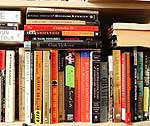Best books to read in June
Marianka Swain recommends three compelling books that take you from London to Paris and Argentina


Mrs P’s Journey by Sarah Hartley Pocket Books (£6.99)
Given the fairer sex’s reputation for being unable even to read a map, it may come as a surprise to learn that the creator of London’s A-Z was a woman.
Phyllis Pearsall, a feisty eccentric from an unconventional background, recognised a gap in the market for a user-friendly, portable map of the city. In the days before computers and sophisticated mapping techniques, she devoted her life to walking London’s streets in order to painstakingly sketch and record every detail.
However, this is not just a tale of cartography. Sarah Hartley has produced a meaty, dramatic account of Phyllis’ family life, centring on the stormy relationship between her tyrannical Hungarian father and passionate Italian-Irish mother, and the effect of these two self-absorbed individuals on their daughter, from a humiliating entrance to her boarding school on horseback to emotional blackmail and callous abandonment.
Mrs P’s Journey is also a wonderful piece of social history, with its representation of the immigrant experience in London in the early 20th century and of the changing place of women in society. Although bright and talented, Phyllis does not receive the same encouragement as her artist brother, and has to fight to gain recognition from cartographers, publishers and retailers, who mistrust a woman entering their sphere.
Despite such social restrictions, Phyllis—and thus Miss Hartley’s reader—goes on many riveting journeys, from sleeping rough in Paris to wandering through Spain, and interaction with figures such as Vladimir Nabokov to playing a role in the war effort during the Blitz.
This is, above all, a great tribute to the courage and indomitable spirit of a pioneer, whose response to any ordeal was simply ‘On we go’.
Exquisite houses, the beauty of Nature, and how to get the most from your life, straight to your inbox.
Bel-Ami by Guy de Maupassant Penguin Classics (£8.99)
Corruption, sleaze, expenditure and scandal. Sound familiar? But Bel-Ami doesn’t depict today’s political system or tabloids, but the experience of a young journalist in belle époque Paris.
What does it take to succeed? And who will you have to seduce, blackmail or destroy to get what you want in life? Ambitious social climber Georges Duroy wins a job as a journalist on La Vie française, and sees it as his opportunity to enter the higher echelons of 19th-century Parisian society.
As Guy de Maupassant records with wry cynicism and wit, his protagonist soon discovers that social recognition and professional success come at a price. He must constantly change alliances, mistresses and, above all, his own identity in order to navigate the shark-infested waters of journalism, politics and upper-class society.
This darkly humorous plotting is set against the backdrop of a Paris that we might recognise from Baudelaire’s account of the flâneur or the Impressionists’ depictions of the beautiful yet seedy underworld of the city. Yet although Maupassant never falls into the trap of romanticising, he does convey the heady joy and pace of the metropolis, with its opulent parties, luxurious fashion and bustling streets, teeming with humanity.
Duroy and the world he embodies may not be morally sound, but they are curiously seductive.
Long after midnight at the Niño Bien by Brian Winter Random House (£16.99)
‘Fall in love. That’s my only advice. It can be with a girl, or with the music, or with the dance. It doesn’t matter. If you do, then the tango, with all the bulls**t that you’ll go through along the way, will have been worth it for you.’
Brian Winter didn’t intend to learn the tango. When he swapped Texas for Argentina after graduating from university, he was putting off finding a job to experience Latin America, hoping to gather journalistic material and some good stories to tell back home.
He was wholly unprepared to find a country on the brink of revolution and to fall in love with the tango—and with a tango dancer. In his frank, funny, personal account, he explores the strong bond between Argentina’s turbulent culture and the tango.
Part travel journal and part social history, Mr Winter cleverly combines his own experience of sweltering heat, dingy bars, rumbling civil unrest and steamy dancing with an exploration of the birth and development of Argentina, from settlers through to revolutions.
I particularly loved the vibrant characterisation. He paints in bold strokes the grizzled veteran dancers who try to teach the young Yank how to master ‘the vertical expression of a horizontal desire’, as the tango is described. They range from B-movie stud El Tigre to The Godfather, who believes that tango is ‘the soul of Argentina’. Such men display a louche, maudlin indolence with occasional glimpses of passion and raw sexuality.
Most winningly, the American’s journey on the road to dancing is amusingly and, at times, poignantly captured, from the first stumbling steps through the gradual absorption into the dance, culminating in an intense obsession, at the centre of which is a longing for a beautiful woman just out of reach. A longing that itself encapsulates the tango.
Country Life is unlike any other magazine: the only glossy weekly on the newsstand and the only magazine that has been guest-edited by His Majesty The King not once, but twice. It is a celebration of modern rural life and all its diverse joys and pleasures — that was first published in Queen Victoria's Diamond Jubilee year. Our eclectic mixture of witty and informative content — from the most up-to-date property news and commentary and a coveted glimpse inside some of the UK's best houses and gardens, to gardening, the arts and interior design, written by experts in their field — still cannot be found in print or online, anywhere else.
